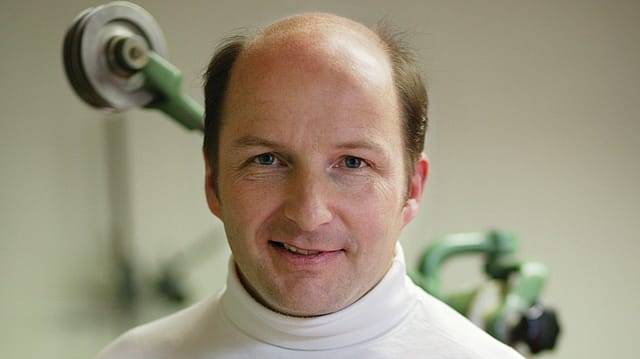From here to eternity
ADVERTISEMENT

TO THOSE WHO know their watches, Kari Voutilainen is undoubtedly a Name. An independent watchmaker, he falls in the small category of one-man watch companies like Laurent Ferrier, Philippe Dufour, François-Paul Journe, and Christophe Claret.
Like the others, Voutilainen (pronounced voo-tea-LIE-nen) is all things: artist, engineer, salesman, marketer, and CEO. I didn’t expect him to fix his own appointments too. Setting up interviews with watch company bosses at Baselworld, the world’s leading watch trade show, is generally an intricate logistical feat. But Voutilainen cuts through all that.
I sent him a request on LinkedIn, and soon after, I got a reply. “I’m in Hall 1.2, we can meet on the 30th, if noon works for you?” And my appointment was fixed.
To those not in the know, Voutilainen is like a Damien Hirst in the watch world. He makes just about 40 watches a year, but each one of them is handcrafted. Many are one-of-a-kind pieces (or strictly limited editions), for which he makes his own bridged wheels, escapements (the contraptions that transfer energy to the minuscule mechanical bits inside a time-piece that make it work), dials, hands, and even the screws for his watches.
Predictably, these watches are far from cheap; they start at 72,000 Swiss francs or a little over Rs 48 lakh, and go up to 350,000 Swiss francs or Rs 2.4 crore. Houses cost less. I’m eager to meet the man behind these watches, and close to noon on the scheduled day, wind my way through stalls run by multinational watchmakers, replete with flashing LEDs and sleek screens showing complicated movements and, of course, the ubiquitous model-hostesses.
December 2025
The annual Fortune 500 India list, the definitive compendium of corporate performance, is out. This year, the cumulative revenue of the Fortune 500 India companies has breached $2 trillion for the first time. Plus, find out which are the Best B-schools in India.
Voutilainen, however, is in a blink-and-you’ll-miss-it booth, tucked away in a bylane in Hall 1.2. There’s no staff ushering visitors in, just Voutilainen and a probable customer. “Give me a couple of minutes,” he says, and keeps his word. Two minutes later, we’ve settled down to talk time.
Do you think you should be making more watches a year, I ask. The answer is an emphatic no. “I will not do more because it will expand my customer base which I will not be able to manage,” he says. There’s already a waiting list of a year. As I see in the stall, he manages customer relations as well. Also, since this is a business to him, he says more watches will eat into profitability. He’d have to hire retailers, which would eat into his margins. I see what he means; he employs 24 people. That’s probably lesser than the number of attendants at the Rolex stall!
In fact, it almost seems like he’s fighting to stay small. “The game changes when you make 200 or a 1,000 watches,” he says. There’s no stock he keeps right now because he sells everything. Most watches have a one-year waiting list. So is it about a shortage of the right talent? That’s not it either. Voutilainen says he keeps getting resumes and it would be the easiest thing to hire 10 more people but it would mean getting into a race to deliver, taking on production of commercial models, which he abhors, and catering to the flavour of the season. “Sure, I will hire more people but it’s going to be very slow. I’m independent. I am only the owner, no partners, no investors.”
From numbers, we move to poetry, as Voutilainen shows me his latest creation, the Aki-No-Kure, priced at 350,000 Swiss francs. It’s a heavy palladium gold piece with an iridescent blue-green dial fitted onto a classic black alligator strap. The outside of the caseback shows a metallic spider sitting in its web spun in real gold; the inside reveals an embellished dragonfly. All the lacquer work on this piece was in collaboration with Unryuan, a Japanese art studio, under the guidance of T. Kitamura, a post-modern lacquer master.
It’s definitely not “modern”, and I think it looks like it comes from a treasure vault in Tsarist Russia. Voutilainen hands me a loupe and I’m transported to a different world, in which green leaves seem to shimmer in the breeze, the spider patiently spins its web, and the iridescent dragonfly seems ready to fly. The details are astounding. “It’s unique,” is all I can manage, and the master accepts it as his due. It’s the only one made, he says.
But then, we are all critics, and I ask why the case is so thick. Luxury watchmakers like Bulgari pride themselves on the thinnest watches, so what’s behind the thick case of the Aki-No-Kure? “My movements are thick but they will last forever,” retorts Voutilainen, sounding offended. “Many use high-tech components made of silicium today but they break down faster and can’t be repaired. They have to be replaced. The other thing is this technology is there today but what will it be replaced by tomorrow?”
So how long will your watches last, I ask, knowing I’m running out of time; there’s already a small crowd outside waiting to meet Voutilainen. He doesn’t give me a straight answer, but tells me that his inspiration comes primarily from the classic Breguet pocket watches that he worked on early in his career. Those tourbillons and half repeaters were over two centuries old and showed no signs of wear or tear on their barrels and escapements, and still kept perfect time. “Stunning,” he says of them. What he doesn’t say, but what I infer, is that time is, after all, the best judge.
